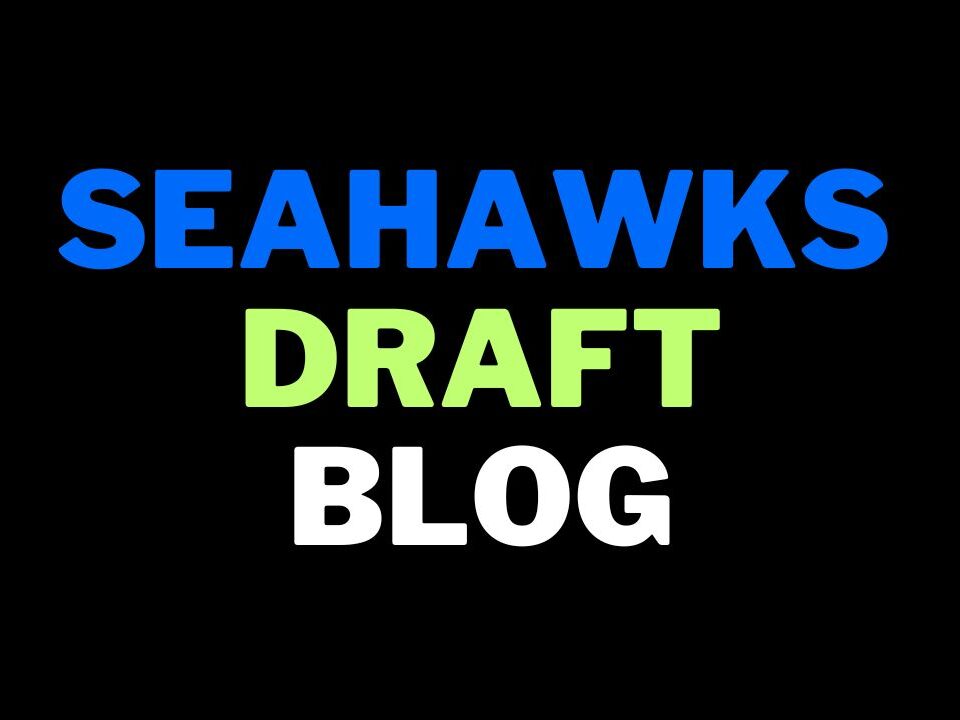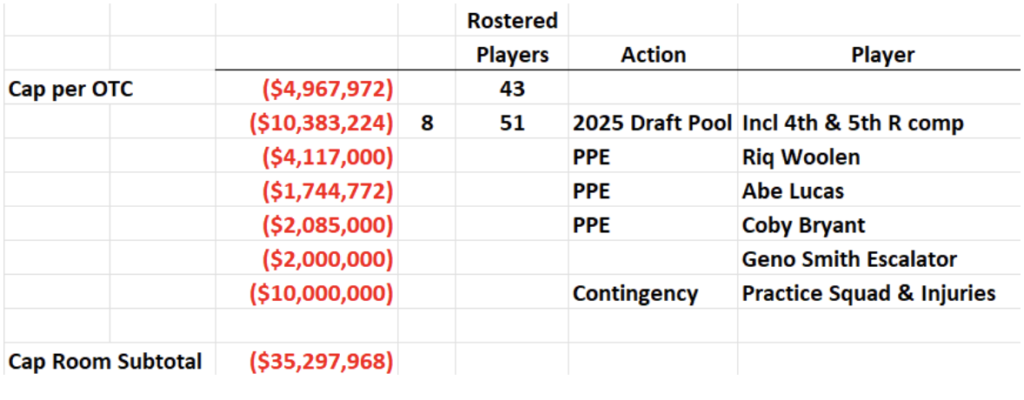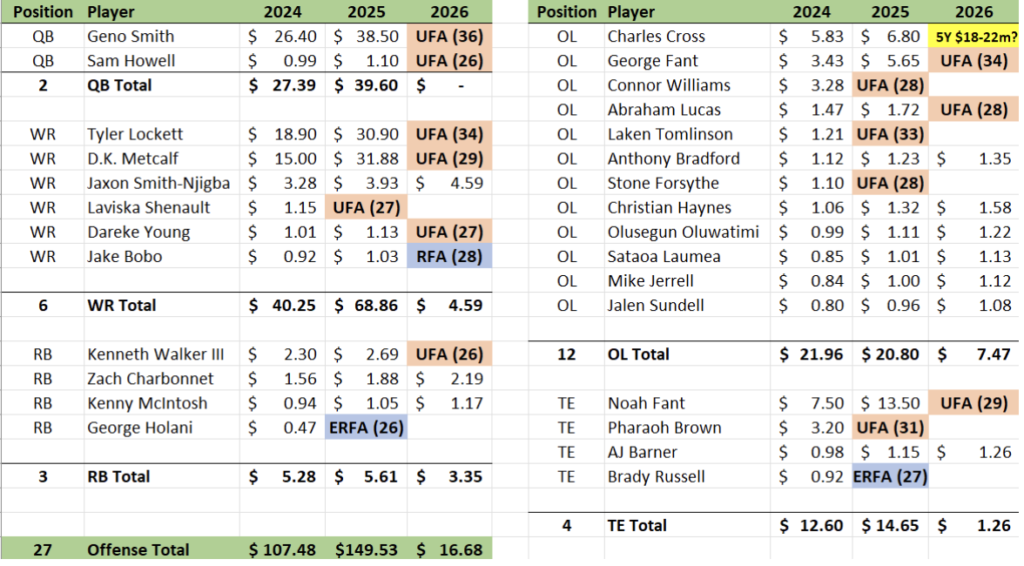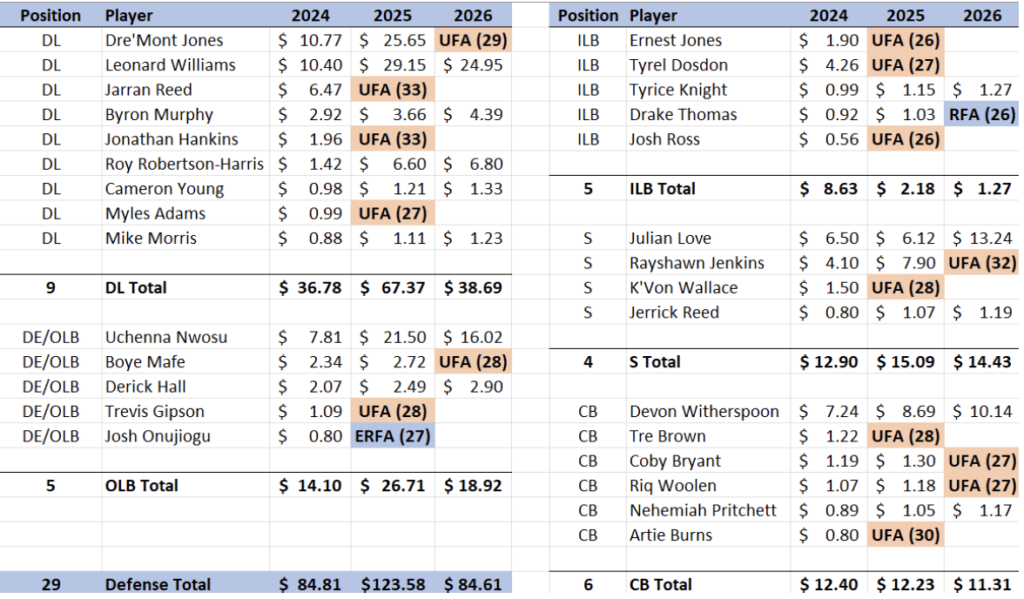This is a guest article by Curtis Allen…
With the trade deadline passing, half of the season is behind us and on a bye week without a game, it is a good time to get a look at where the Seahawks stand on the salary cap for next season.
The team is currently on a 1-5 run and has questions about a disaster of an Offensive Line and several big decisions to make on other major parts of their roster. Year one of the Mike Macdonald era most certainly included some inherited roster pieces and salary cap constraints that were not necessarily of his design. Year two will likely provide a much clearer picture of his ultimate vision.
At the bottom of the piece, I have included informative snapshots of the roster as it stands today according to OverTheCap (OTC). Included are cap hits, free agent status’ and age when they would enter their next contract. You can get a ‘big picture’ idea of the 2025 and 2026 needs the team has, the cap hits they will need to manage and what position groups most need to be addressed.
As you are probably aware, the Seahawks are projected to have no cap room next season. Combining that with some young players that will need second contracts, some decisions that need to be made on expensive veterans and position groups that need a major overhaul and the potential for a volatile offseason is high.
Maybe ‘transformative’ is a more positive word. This roster and cap will look substantially different when the team kicks off next September.
The goal of a piece like this is not necessarily to forecast exactly what the Seahawks will do. It is to frame the picture in a way that we can start thinking about what points need discussion throughout the balance of the season and into the offseason.
We need to start with basic costs the Seahawks will likely incur next year that are not currently accounted for but are an unavoidable reality. Then we can talk about how to account for the roster pieces they need to be more competitive.
If you have read our salary cap pieces before, we tend to follow the ‘depress you first, then tell you why it is not so bad’ method. I say this as a forewarning because it is very likely the Seahawks’ checkbook is going to burst into flames at some point in 2025. Use of the company credit card as a supplementary cap tool will be compulsory and whoever monitors their dead cap spending will need a drink.
An Estimate for 2025 Cap Expenses
Here is our top look to get started with:
At the top, we have the current cap number for the Seahawks next year in red. That includes cap rollover from 2024.
These numbers are fluid. OTC has projected a robust 6.7% growth in the cap for 2025. We will not know the actual number until February but they usually have a very good finger on the pulse of revenues, etc.
What follows is OTC’s current estimate of their draft pool, which is also fluid. They base it on the current draft position, which changes weekly. As they win games it pushes their picks down and they get less expensive. As they lose, the opposite happens. They nicely also include projected compensatory picks and the Seahawks have two coming their way.
At this point, the Seahawks have their top 51 cap spots covered. There is no need to add any base salary slots to get to Effective Cap Space (which is $15,351,196 over the cap).
Next you have the Proven Performance Escalators. These are salary bumps baked into the Collective Bargaining Agreement for good rookie performance that increase a player’s salary on the fourth year of his rookie contract. Riq Woolen earns the biggest bump as an original ballot Pro Bowler. Bryant and Lucas’ bumps come by virtue of their playing time.
Geno Smith is projected to earn a non-guaranteed $2 million for achieving the ‘yards’ escalator in his contract.
Lastly, we have funds for the Practice Squad and some slush money to replace players that go on Injured Reserve. Nobody likes to pay or account for these expenses but they are always a reality. They’re the two end-pieces in a loaf of bread. They serve a purpose but usually get discarded easily.
The Seahawks need to come up with approximately $35 million in cap dollars just to pay the bills and get their heads above water, let alone dramatically improve their team in 2025.
We are not done digging. The hole gets deeper when you consider the Seahawks have players to extend that I think the majority can agree are priorities.
Buckle up, because we are about to spend about $360 million of Jody Allen’s money.
A Look at Five Extensions the Seahawks Should Consider
This is a lot to swallow.
Starting at the top we have Ernest Jones. The Seahawks’ handling of Jones appears to be something like acquiring Leonard Williams in his free agency year and then extending him early in the new league year. Considering Jones’ pass-rush ability and the value placed on him by the Seahawks given the compensation they gave up, a contract similar to what Patrick Queen got from Pittsburgh and Jeremiah Owusu-Koramoah got from Cleveland is what he will require. A three-year contract takes him to his late 20’s and firmly establishes him in the middle of Mike Macdonald’s defense.
Riq Woolen has had a standout career so far. He has had some challenges to be su but his body of work is outstanding and corners (and just plain athletes) like him are very hard to find. He nets an extension in the range of Patrick Surtain and Jaire Alexander.
Kenneth Walker is an offensive fixture for this team. He is an explosive playmaker who has not reached his ceiling. An extension in the range of Josh Jacobs and what Chuba Hubbard just received to keep Walker as a heart-and-soul piece of the offense is appropriate.
Boye Mafe has had a fantastic rise from talented prospect to streaky pass rusher to more well-rounded Outside Linebacker. He may never reach that high plateau of game-breaker like Bosa or Garrett but he is firmly planted in the level just below. A contract like what Rashan Gary or Jonathan Greenard received is needed to keep him in Seattle.
D.K. Metcalf is a player capable of re-arranging the entire field. He can excel as an intermediate target with explosive capability, or as a deep target that can change a game at a moment’s notice. From a salary cap standpoint, he is a homegrown player the Seahawks have been able to maximize their value with.
From vastly outperforming his rookie contract to signing an extension that had an affordable cap hit in the first year (and is set up to allow for restructuring for cap purposes) to now in 2025 having a cap number that allows a reduction in the cap hit when being extended. OTC says the Seahawks can gain up to $13.8 million with an extension.
We propose a 3-year contract near what CeeDee Lamb and Justin Jefferson received that takes Metcalf through his age 31 season. That essentially covers his prime years and allows the Seahawks to save $12 million on the cap in 2025 (I rounded down slightly).
Figuring some standard contract structuring, the Seahawks add a net $8.5 million in cap for these five extensions, putting them over the cap by $44 million.
Can they find that kind of cap space? And even more to make sorely needed improvements on the Offensive Line?
They can.
That does not mean they are easy choices.
The Five Likeliest Options to Pick Up Cap Space
We have to start with the unkindest cut of all. Tyler Lockett has been a Seattle Seahawk through and through. But the Seahawks committing more money to D.K. Metcalf and more targets to Jaxon Smith-Njigba means that as a practical matter, they cannot handle a $30 million cap hit for a third wide receiver. If he wanted to keep playing in Seattle, could they adjust his contract to make it more workable? I would be 100% behind that. It does appear just as likely, though, that last year’s contract reworking was done with an eye toward Lockett retiring after 2024.
Dre’Mont Jones has been a tough signing for the Seahawks. He played a good chunk of 2023 out of position and needed another high-profile acquisition in Leonard Williams to restore him to his original position and unlock more productive play. This year he has three sacks, five tackles for loss and thirteen pressures in nine games. More than once in the Rams game, he was the beneficiary of the Seahawks setting him up like they did for Jamal Adams: Putting him on the edge and blitzing linebackers into the middle gaps to give him a free run at the quarterback. That is not what he was acquired for. Players with that kind of investment need to make their own plays.
Noah Fant might be the biggest misfit toy on the roster. After 2022, his career numbers and trajectory were comparable to T.J. Hockenson, who continued blossoming and signed a $66 million extension in 2023. What did Fant do in Seattle that year? He had his career-worst season. Yet the Seahawks wanted him back and he wanted to come back on a short contract.
After nine weeks of the season, he is the #23 most-targeted tight end in the NFL. Want some lemon juice on that papercut? Both Will Dissly and Colby Parkinson have more targets with their new teams than Fant does in Seattle. His last touchdown catch was in garbage time against the Chiefs nearly two years ago. Fant is currently #14 in First Downs as a tight end.
So, not a superstar blocker in the run game, not a prolific target, in those targets he has zero touchdown catches and is not a first down machine. Unless something phenomenal happens in the next eight games, he should not be on the roster at $13.5 million next year.
Uchenna Nwosu is the polar opposite of Fant. He is a perfect fit on this roster and easily one of their best acquisitions in recent years. His challenge is obvious – health. He played six games last year and was a fantastic piece on defense. But his injury badly hurt the defense. So far this season, he has only played in one game and they need him just as badly.
However, another harsh reality of salary cap life is he cannot play on a $21 million cap number in 2025. If he is healthy and open to a reworking of his contract – perhaps trading some of his non-guaranteed salary for incentives – the Seahawks should make every effort to keep him.
Rayshawn Jenkins has not been a great acquisition for the Seahawks. His one claim to fame is the 102-yard fumble return against the Giants. Other than that, he has had real difficulty finding his run fits as a strong safety and landed on injured reserve. The Seahawks have affordable depth behind him and in a cap crunch could find a way to move on from him without too much difficulty.
Pulling all these levers gets them in the black and allows them approximately $6.6 million to spend as they wish. Is that enough cap space to fill some of the key roster spots that have opened up? Let alone invest in completely rebuilding the Offensive Line with quality talent?
It is not. If every move in this projection were made, they would need another serious pass-catching threat with Lockett and Fant gone. They would need more depth along the defensive line if Nwosu and Jones were gone.
They would be running out Tyrice Knight at linebacker (which appears to be a certainty with the release of Tyrel Dodson). They also have Jarran Reed’s spot to consider, as he is an unrestricted free agent.
They could pick up some of the slack from players like Byron Murphy, A.J. Barner and Jake Bobo progressing. Some depth could be added in the draft. But walking out of the draft with 3-4 immediate contributors is more the exception rather than the rule.
More cap room is needed. And more is available. In fact, I am ready in November to call my shot for this coming offseason on a move that I do think the Seahawks will make in some form.
Restructuring Leonard Williams’ Contract
There are many reasons why this is a workable solution for the Seahawks to gain more cap space.
Firstly – as we have seen – the Seahawks badly need cap space in 2025. Williams has a $20 million salary the Seahawks can work with to convert to bonus money to create room. OTC currently projects that they have $168 million of cap room in 2026 and $285 million in 2027. Even with the young players they will need to give second contracts, they have room on the credit card to borrow some future cap space.
Secondly, Williams is the kind of player you want on your team long-term. His current contract covers his age 31 and 32 years. His skillset will age well, he is versatile and he is adopting a leadership role on the team.
And thirdly, the Seahawks have established a bit of a pattern with restructuring. In 2023, they employed it with Jamal Adams, Quandre Diggs and Tyler Lockett. This year, with Dre’Mont Jones and D.K. Metcalf.
Admittedly, that is not a great success rate — but there is a compelling case to be made they can make it work with Williams.
OTC says Seattle can gain $9.37 million with a Williams restructure. Let’s follow Joey Laine’s recent restructures and add two void years. That brings the cap gain to just over $14 million for a nearly $21 million number to add talent.
Let’s be right: that number is good. But not a windfall. The Seahawks will need to be very, very careful in their allocation of resources if they want to address a critical issue such as rebuilding the offensive line.
Turning A Weakness into a Strength
The Seahawks need to find linemen they can build around and get some continuity. Patching together a line with young players who are not ready, acquiring spare parts and praying for no injuries has not worked.
I believe the Seahawks will at the very minimum need to pursue a “1+1+1” strategy in the 2025 offseason to rectify their challenges along the Offensive Line:
-Sign one premium free agent
-Draft one starting-caliber lineman
-Develop one of their current players into a starter
At the moment, with what we have seen this year, all three of those seem unreachably high goals. But the they must try.
Why not just buy three linemen? That definitely is an option. But a big sweeping investment is just not on the cards with the cap space they have.
For instance, the top guards net $20 million per year contracts. A first-year cap hit for one of those players will cost between $10-12 million. Higher yet due to the lack of blue-chip interior players likely to be available in March. Trey Smith of Kansas City is the head and shoulders best guard available. The next closest is Zach Martin, who may retire instead of pursuing free agency. Aaron Banks from the rival Niners might be an option.
They have more choices at the center position. Two fan favorites to anchor the line and bring some toughness and leadership would be Ryan Kelly of the Colts and Bradley Bozeman of the Chargers. If either of those players are available, the Seahawks should be interested. A first-year cap hit of say a 3-year free agent contract would be about $7-9 million.
There are many second-level options available like Drew Dalman (who will be coming off IR) of the Falcons, Josh Meyers of the Packers, Coleman Shelton of the Bears and the Seahawks’ own Connor Williams.
Seahawks fans would much prefer a long-term signing at center rather than the nibbling at veteran stopgaps like they have done in recent years. But will the Seahawks pursue that avenue? The play of the line so far this year begs a re-evaluation of their process.
The best outcome for all involved appears to be taking an aggressive approach. Entering the 2025 draft with these spots addressed might be ideal:
LT-Charles Cross
LG-open with Lumea and Haynes in the mix
C-Top Free Agent signing
RG-Top Free Agent signing
RT-(please oh please) a healthy Abe Lucas coming off a very solid 7-8 games in 2024
They can target a top left guard or draft any other line position to develop depth.
That’s the dream, isn’t it?
It likely would take all of their available cap space to make that happen.
They still will need more money to fill in some of the gaps and a little more cushion for in-season trades or have some money to roll into 2026.
Which brings us to the wildcard of the entire offseason.
Looking at the Future of the Quarterback Position
Geno Smith will be entering his age 35 season next year as his last contracted year with the Seahawks. His cap hit is currently $38.5 million but as we discussed at the top, let’s call it $40.5 million as the chances he hits his yardage escalator are very good.
The options:
-Cut or trade him before his Roster Bonus hits March 20 and pick up $27 million of cap room
-Extend him. OTC says the Seahawks can pick up just under $19 million with an extension
We took a walk through some of the thought processes at quarterback in April and most of those points could also be applied to the 2025 offseason.
Will Smith quarterback the Seahawks in 2025? I doubt the key decision-makers in the Seahawks’ front office have made up their minds yet. There are still eight games left in this season to size up the roster.
There’s only one thing I am absolutely certain of. He will not play on his present 2025 cap number. The Seahawks will need to make a decision instead of just playing the season out at his present contract rate.
The same could be said for Sam Howell. We do not know if the Seahawks like what they see behind the scenes. He gradually improved in training camp and had some good plays in preseason.
If they do rate Howell, I could see the Seahawks extending him as one of their early moves of the offseason. Something that elevates him to the going rate for backup quarterbacks and has some incentive built in should he hit some numbers.
A 2-year, $11.5 million contract would give the Seahawks some security in a volatile offseason. They are protected if they want to move away from Smith, or if extension negotiations come to a stalemate. Also, they could go into the draft and not be forced into an expensive posture if there is a quarterback they like.
As for Smith, I personally could see the Seahawks taking either route next year. They’ve enjoyed getting great value for their cap dollars with him but a big number like $40 million may just be too expensive.
A key decision point is Smith’s age. He will be 36 in 2026. Would the Seahawks (or any other team) want to give a quarterback a big new contract for his age 36-38 years? I know fans like to point to the six years he spent on the bench as evidence his body is fresher than the standard quarterback. But is that how NFL teams think?
He did not have much of a market after 2022 — what we now can confirm is his career-best season statistically. Would that change after two lesser seasons and two more years on the calendar?
At his age, guaranteed money is more important in a new contract than Average Annual Value.
I could see the Seahawks choosing to extend Smith on something like a two-year $65-70 million contract with $35-40 million guaranteed and some incentives. The Seahawks can bank on him as the starter in 2025 and 2026, have two drafts to pick up a young quarterback and then have a look at things in the 2027 offseason – his age 37 year – and make a decision.
I have no doubt Seattle will pick up some salary cap money next spring from the quarterback spot. How it is done is up to them. It will be fascinating to witness.
Offense
Defense
Special Teams
Finally, Rob appeared on Dan Viens show today to talk about the Seahawks and the NFL draft, check it out here:








